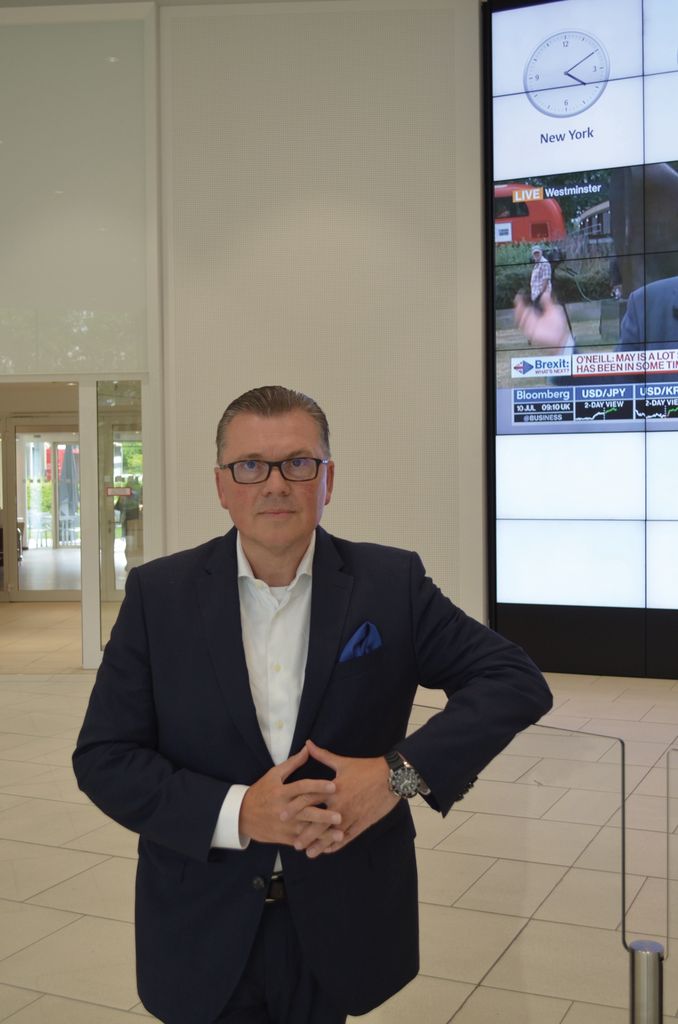Andreas, please tell us a little about your job and day to day responsibilities within Allianz Global Investors?
Let me start from the top. We as a centralized execution desk define ourselves as a service provider to our portfolio managers and clients. In this function we act as advisors to our strategy teams and to be their “eye, ear and fingertips” on various asset classes and markets. Our key task is to guarantee best execution following our best execution policy which is embedded in our global trading policy. I oversee a team of experienced senior FX traders who all have more than 15 years of industry experience, not only in FX execution but also as traders in other asset classes and overlay managers, analysts or process specialists. This combination of experience and skills enables all our traders to support the day to day challenges of execution and all related tasks. At Allianz Global Investors we are in close interaction with our risk, compliance and legal teams in order to be ahead of the curve regarding regulatory and risk boundaries within our market playing field. For the teams, the understanding of the challenges and interests of our portfolio managers and their envisaged strategies is key for the value we are able to add from the trading and execution side.
How hands-on do you like to be when executing your order flows and how much importance does the firm place on continuously working to improve its technology and trading platforms?
Very high attention and effort is taken to continuously optimize processes and to make use of state of the art technology to support this task. Almost 100% of our order flow is generated via electronic order management systems, channeled through compliance and risk analysis tools to finally arrive at the execution desk. Depending on client guidelines and market restrictions trading will now decide to pass the orders in single, block or batches to the appropriate execution systems for pricing and execution. After execution the fills are automatically allocated and distributed for booking and confirmation, positions are instantly reflected in the respective portfolio. Close cooperation and frequent dialogue with our IT and front office services is an essential part for maintaining existing work-flows or to improve and develop new and more efficient ways for execution. After trade processing, including a robust and fast escalation process in case of mismatches is a must.

Allianz Global Investors operates from 25 global locations
With MiFID II coming into effect this year the focus on transparency around best execution has increased. In what ways has this influenced how you go about measuring and evaluating your own trading strategies and need to explore new execution alternatives and ways to undertake them?
Even before the formal introduction of the MiFiD II framework, trading in general has become far more process oriented. Trade reporting across the entire value and audit chain has become another key element in the execution cycle. High attention is taken on the ability of AllianzGI’s systems to be able to support such tasks and to have adequate functioning interfaces to communicate to the various receiving ends within and outside the company.
How long has your trading team been using FX algorithms and how do you source and access them?
Systematic machine run FX algorithmic execution is a comparatively new way for us to handle FX order flow. However, the so called “human algorithm” which refers to the sole trader or portfolio managers skill to execute orders related to underlying asset execution cycles or strategies as well as market liquidity considerations has always been used. Advanced systematic algorithmic execution has of course had a long history on our own equity trading desks and is now also becoming a focus for our FX dealing activities as well. Starting from an intellectual basis and after discussion with various service providers we are starting to get more comfortable with the concept of algorithmic FX execution. As part of this process AllianzGI has been making an effort to introduce and educate our final users about algorithmic trading and how it can be adopted in parallel to pure market or limit order executions. FX spot and forward orders as single allocation or block are usually passed from our original order management system into an execution manager. From here these orders are populated to either single counterparties or ECNs. The usage of proven easy to handle or even custom made default set-ups is key to us. The functionality of algorithms should be as advanced, flexible and intuitive at the same time but will always be under revision.
What types of FX algorithms are your trading team currently employing and what factors generally influence this?
Commonly we stick to the KISS – keep it short and simple – principle: simple algorithms executed usually in a short period of time due to the nature of our business is currently the norm. TWAP and it’s derivatives in various shades of time and aggressiveness currently play the key role for this. But don’t get me wrong: no execution demand will always follow the same pattern nor does the style of an algorithm. Therefore, there is a constant need for intelligent adjustments.

I would prefer to have a small set of algorithms which always give me enough choice and ability to change ones execution style
What are the key things you are trying to achieve when using algorithmic trading techniques?
As mentioned earlier one of the key drivers is a sound understanding within our trading team of what should be achieved for the portfolio manager and to enhance his related strategy. An initial examination of market dynamics and liquidity is the starting point for a decision on what execution style is ideal. The motivation can then be multifold, with the key elements taken into consideration at all times being best price, lowest spread, lowest market impact, safe execution and settlement, plus transparent and timely execution reports.
What are the key benefits that you are getting from algorithmic trading?
In short, widespread and systematic access to markets and liquidity, optimization of smart order placement. Consequently algorithmic trading has become an important additional execution layer next to the standard market, limit or benchmark execution.
How has the way you use FX algos evolved? For example, when you first adopted them were you more inclined to micro-manage their use and more frequently change settings and limits etc. than you are now?
You should not be naive when entering the algo space but you also need to be entrepreneurial and – let’s say – a little adventurous when starting to use these tools. More precisely you need to take absolute care of all the technical, operational, risk, compliance and legal set up issues for all involved parties and platforms. This also includes transparent and adequate spread and cost pre-negotiations; clarification of allowed and wanted information flows between the buy and sell side teams; Chinese Walls versus one stop shop service; risk-driven instant exchange of information and interference in running processes; discussed and defined potential time gaps and the embedded risks. Usually one would start with smaller order sizes in liquid currency pairs to see how stable or fragile the process is. Once proven successful one would then look for orders where algorithmic execution can potentially add value, such as larger size orders, particular time patterns or simply random average execution, if no strong market view is given.
Are you happy to pioneer the use of new algos or do you prefer to stick with the tried and tested ones?
There is no clear yes or no answer to that. You first need to identify the core motivation of a given FX order and the targets related to it depending on the PMs strategy or tactic. I guess one should not be tempted to simply use a new algorithm for the “algo sake”. You first need to understand the mechanics and dynamics of the strategy before applying it to your execution. Let me give you another example or metaphor. I like to drive cars that can be very modern ones with all kinds of features helping you to keep control of the track. But I also like old cars where you need all of your human senses to drive fast but also efficiently and safe too. So generally I would prefer to have a small set of algorithms which always give me enough choice and ability to change ones execution style in respect to speed, aggressiveness, partnering, randomness and anonymity. So I always want to be in control when I am in the driver’s seat – be it on the Autobahn, traffic calmed areas or even off road (e.g. to emerging markets). In a nutshell, over-engineering does not always makes sense and leads into dead-end streets or even crashes like in autonomous driving.

Allianz GI has been making an effort to introduce and educate our final users about algorithmic trading
Let’s talk about TCA. What do you see as the biggest challenges in trying to compute accurate execution metrics in FX? Is it just a problem of sourcing suitable data sets?
There is a great deal of attention being given to FX TCA nowadays but with the usual known unknowns. First you need a clear and sound date set with time stamps broken down to the second. That’s the basis to do further analysis against various benchmarks you want measure it against. That can be a simple internal target or limit, goes to mid pricing, risks price at inception or market slippage, to name just a few key figures. On top of this exercise our own team tries to take a holistic view across asset classes and desks with the target of having a multi asset TCA.
What’s your opinion about the relative advantages of using third party benchmarks versus tools that a firm can run against its own data?
You will face the challenge to define a neutral benchmark which can simply be the alternative executing in competition when markets prove liquid and has the simple advantage of the risk transfer. More and smaller independent companies as well as institutions are looking into the area of data generation and aggregation and to sell those parameters possibly with a TCA service directly attached to it. Going forward this will play a crucial part in advanced analytics.
How do you use TCA to evaluate the effectiveness of algos?
This will always be a work in progress and boils down in the first place to the definition of appropriate measurable benchmarks with a sound data set. It is certain that this area will develop much further as regulators, asset managers and finally clients will and need to look into it with granular and holistic analytics, ideally along the full value chain. This starts with idea generation by PM through the full lifespan of an order, the execution venue itself plus alternative routes you could or should have gone.

Commonly we stick to the KISS – keep it short and simple – principle
Is one FX TCA toolset ever likely to meet all the needs of a large firm like Allianz Global Investors or does the complexity involved require multiple solutions?
With rising complexity the demand for more complex analytics will increase, especially from firms like ours who undertake a multi asset class multi desk approach. Today you have a lot of good specialist TCA vendors all having their competitive advantages and limitations. However some larger providers are already developing tools for just this kind of demand. Nevertheless it will always be a challenge to judge what suits us best. The one size fits all might not deliver enough granularity but potentially delivers an easier to digest output at lower cost versus very individual and flexible slice by slice, pool by pool analytics. For the time being AllianzGI runs a split model until we believe we have the appropriate supporting tools and reports at justifiable prices.
Some providers now offer real time analytics and performance indicators for their FX algos. How useful and important do you expect these advanced toolsets to become for firms like Allianz Global Investors?
That’s for sure where we are heading too. Pre and at trade analytics will be even more crucial than the classic post trade TCA. As an active asset management house we need to make on the spot analytics in order to prove our best execution efforts in-house, in front of trade compliance and the client and in context of regulatory requirements alike. The usually raised questions are: “Why did you go for the one or other way of execution and under what risk and liquidity parameters?” Naturally this demands a systematic and automated way. However, the future will show what value added can be achieved by doing so coming from a gut feeling trade approach going to high end analytics, supported by artificial intelligence and machine learning networks.

As an active asset management firm we need to make on the spot analytics in order to prove our best execution efforts in-house
The correlation between the cost of one particular algo and the direct benefits it delivers is not always consistent. How do you address that when determining which ones to use?
There is still a way to go here. A post trade analytics rule set needs to be developed to choose the optimal venue for execution. In this context fixed execution fees charged will play a crucial role, too, when performing full cost analytics. A clear extradition of the charges needs to be clearly tracked and allocated. This is still a rather new concept in the FX world next to pure price spread. Although I believe extra charges are questioned in nature and come under scrutiny and will disappear over time at least for the standard offerings.
Do you have a wish-list of things you would like developers of FX algos to focus on with respect to their functionality and the associated analytical toolsets they offer which would enhance even further their usefulness for firms like your own?
Of course there is always room for improvement on both sides. To stress again the key buzz words for us are: liquidity, flexibility, safety, robustness, transparency. We like a wide range of providers offering a good and stable pool of liquidity ideally with no Last Look. All algos should enable us to control the various parameters in a similar fashion so we are able to compare. The look and feel of the tools should be pretty standardized where needed in order to quickly and safely put it in an order and trigger the execution. In our specific case this is done via one or two multibank platforms only and are part of our OMS. Real time execution with time, size and liquidity pools used must be directly visible. Forward pricing and block trade facilities are important to have clean straight through processing. An exit or at-market button should be embedded for unforeseen market developments and volatility. Last but not least an instant interference via the FX or eFX sales force should always be given to add to flexibility and safety.
Can you see any risks in using algos or conflicts of interest that might arise between provider and user and what sort of due diligence do you undertake especially with regard to banks and their Chinese walls and order flow controls?
Yes, the potential conflict lies in the nature of the business and can never fully be excluded. A split responsibility regarding the flow and the information provided might be handled from different teams. However such business models must be built with a clear governance and defined control mechanisms. On another more formal side this could also be part of the FX Global Code commitment of all relevant market players.
What approximate percentage of your order flow currently involves the use of FX algos and do you expect to see their use expanding amongst many more currency market participants in the future?
FX algo execution is still at an early stage with us and accounts for less than 5 % of our total execution turnover. It is, however, more important if you look at it in relative terms for bigger order sizes. Going forward algorithmic execution will gain importance if all parameters and data gets more measurable and underlying asset driven short term flows more predictable. Systematic somewhat automated execution will play a more prominent part in the entire execution cycle at AllianzGI.



